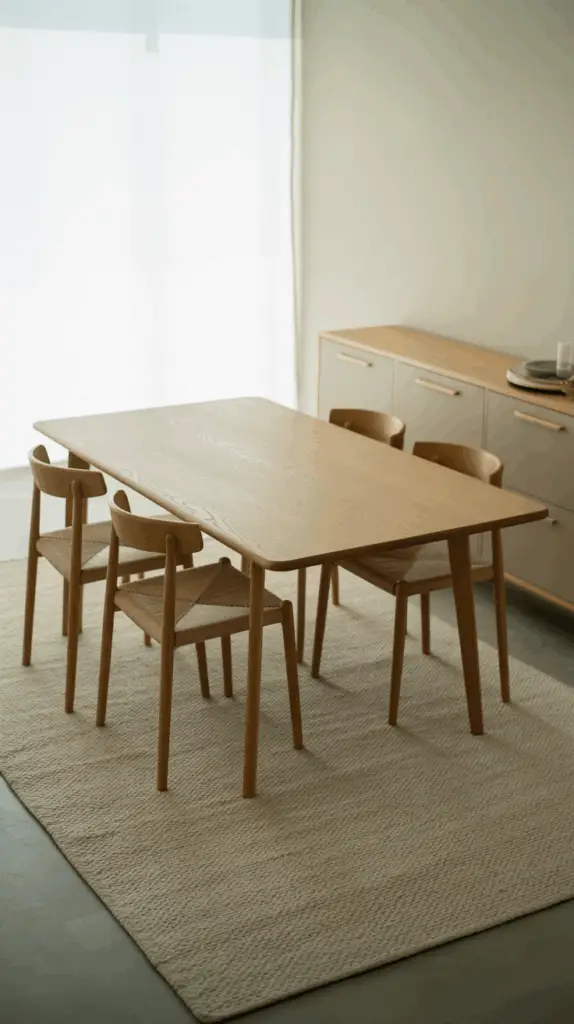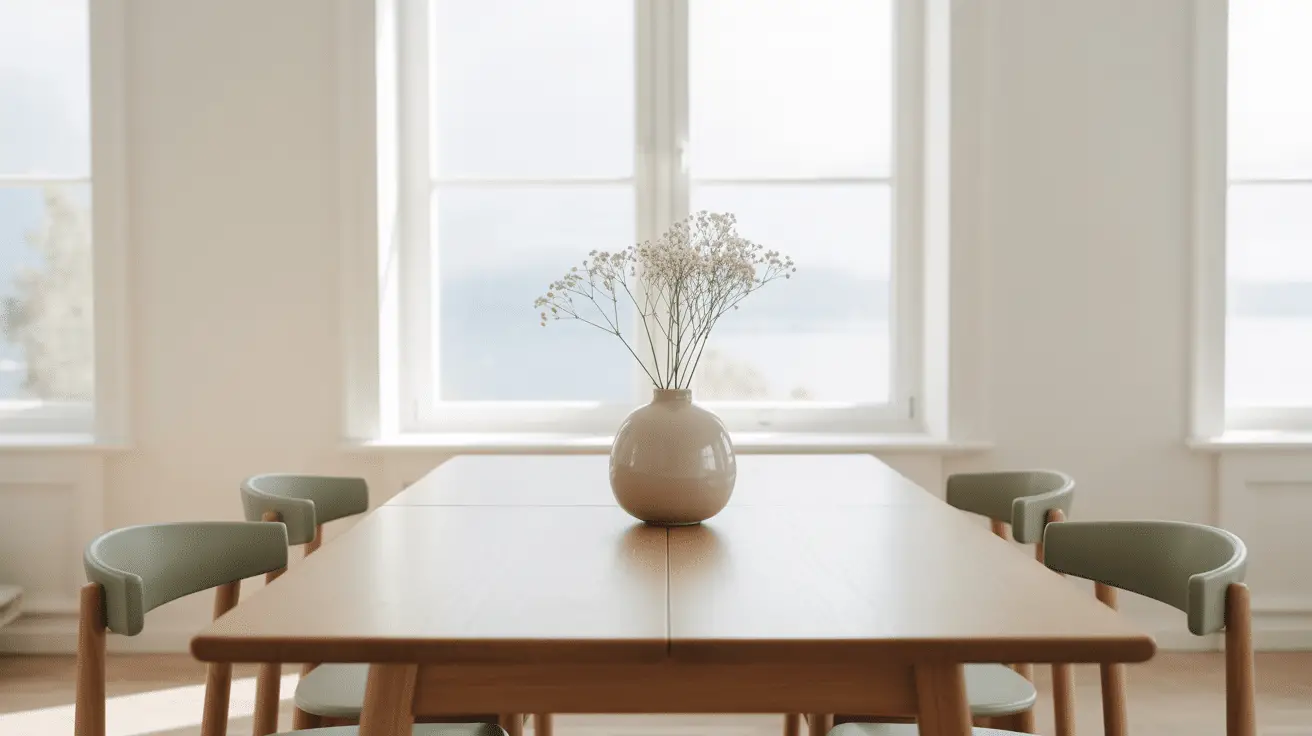Scandinavian Dining Room Inspiration for Minimalist Living and Timeless Style
Table of Contents
Introduction
Minimalism is more than just a design trend—it’s a lifestyle that prioritizes simplicity, functionality, and beauty in everyday spaces. Nowhere is this more evident than in Scandinavian design, which has become one of the most sought-after aesthetics in modern homes. According to interior design surveys, Scandinavian style ranks among the top three global home décor preferences, particularly admired for its calming atmosphere and timeless appeal.
The dining room, often the central hub for meals, gatherings, and connection, is an ideal space to showcase this style. A Scandinavian dining room balances clean lines and functional layouts with warmth, natural materials, and understated elegance. It strips away clutter without sacrificing comfort, resulting in a room that feels both livable and refined.
This article explores Scandinavian dining room inspiration for minimalist living. We’ll look at the foundations of color palettes and natural light, essential furniture choices, and the textures that bring warmth into pared-back spaces. You’ll also find ideas for incorporating storage, lighting, and finishing touches to make your dining area not just beautiful but also practical. Whether you’re designing a new space or refreshing an existing one, these insights will help you create a dining room that embodies the Scandinavian spirit—simple, timeless, and welcoming.
Setting the Foundation with a Scandinavian Color Palette
The first step in crafting a Scandinavian dining room is choosing a color palette that sets the tone for simplicity and calm. Neutral shades dominate this style, with whites, soft grays, beiges, and muted earth tones forming the foundation. These colors not only reflect natural light beautifully but also create a sense of openness and tranquility.
Layering is key. A whitewashed wall can be paired with light wood furniture and accented with darker tones like charcoal or muted greens for depth. To avoid sterility, subtle warm hues—like sand, oatmeal, or blush—can soften the starkness of neutrals and make the space more inviting.
Table: Scandinavian Dining Room Color Combinations
| Base Color | Accent Color | Mood Effect |
| White | Soft Gray | Clean and timeless |
| Beige | Muted Green | Calming and organic |
| Light Gray | Charcoal | Modern and grounded |
Choosing Essential Furniture for Simplicity and Function
Furniture is the heart of any dining room, and in Scandinavian design, it embodies both function and form. A dining table in natural wood is a staple, often crafted from oak, ash, or birch. The look is typically clean-lined, avoiding ornate details, yet offering craftsmanship that feels timeless. Chairs are usually simple, ergonomic, and made from natural materials, sometimes paired with upholstered cushions for comfort.
Storage pieces such as sideboards or cabinets should also serve dual purposes: providing space for essentials while keeping visual clutter to a minimum. Floating shelves or built-in cabinetry work well in small spaces, offering functionality without overwhelming the room.
Table: Key Scandinavian Furniture Elements
| Piece | Material Choice | Design Purpose |
| Dining Table | Oak or Ash Wood | Warmth and durability |
| Chairs | Wood or wicker | Comfort with simplicity |
| Sideboard | Minimal design | Hidden storage |

Natural Light as the Ultimate Design Element
Natural light is one of the defining features of Scandinavian interiors, particularly in dining rooms. In regions with long winters and limited daylight, maximizing light is essential. Large windows with minimal treatments, such as sheer curtains or no coverings at all, allow the room to feel airy and open.
Mirrors can be strategically placed to reflect light, while light-colored flooring and walls enhance brightness. For artificial lighting, pendant lamps in matte finishes or clean metal designs work beautifully above the dining table, offering both function and sculptural appeal.
Table: Enhancing Light in Dining Spaces
| Method | Application | Effect |
| Sheer Curtains | Window dressing | Softens but lets light in |
| Mirrors | Opposite windows | Expands brightness |
| Pendant Lighting | Over dining table | Adds focus and ambiance |
Layering Textures for Warmth and Comfort
While minimalism often risks feeling cold, Scandinavian dining rooms achieve coziness through thoughtful layering of textures. Natural fabrics such as linen, wool, and cotton add warmth, while organic materials like jute rugs and wicker chairs provide tactile contrast. A wool throw draped over a chair or linen cushions on benches create small yet significant touches of comfort.
The table setting also contributes to texture. Stoneware dishes, handmade ceramics, and glassware in subtle tones add an artisanal touch. Combined, these layers elevate the minimalist aesthetic into something lived-in and welcoming.
Table: Texture Layering Ideas
| Material | Use in Dining Room | Effect |
| Linen | Curtains, cushions | Casual softness |
| Wool | Throws, rugs | Warmth and comfort |
| Ceramics | Tableware | Handcrafted charm |
| Wood | Furniture, accents | Natural grounding |
Lighting Choices that Complement Minimalist Living
Lighting in a Scandinavian dining room isn’t just practical—it’s an opportunity to enhance design. Pendant lamps are the most common choice, often featuring matte finishes, simple shapes, and muted colors. Clustered pendant lights or oversized single fixtures can make bold statements while maintaining minimalism.
In addition to overhead lighting, consider wall sconces or table lamps on sideboards for softer illumination. Candles, too, are essential to Scandinavian living, creating hygge—a Danish concept that celebrates coziness and contentment.
Table: Lighting Options for Scandinavian Dining Rooms
| Type of Lighting | Best Placement | Impact |
| Pendant Lamp | Over dining table | Functional focal point |
| Wall Sconces | Side walls | Warm, indirect light |
| Candles | Tabletop | Cozy atmosphere |
Incorporating Storage Without Sacrificing Minimalism
Storage is critical in minimalist design, ensuring surfaces remain clutter-free. In Scandinavian dining rooms, storage pieces are understated yet highly functional. A slim wooden sideboard provides space for tableware, while built-in cabinetry blends seamlessly into walls.
To maintain the clean aesthetic, opt for hidden storage rather than open shelving, unless shelves are carefully curated with ceramics, glassware, or plants. Functional pieces, like storage benches, serve a dual purpose: offering seating while hiding dining essentials.
Table: Storage Solutions for Minimalist Dining Rooms
| Storage Piece | Benefit | Style Fit |
| Sideboard | Conceals clutter | Sleek and simple |
| Built-in Units | Seamless integration | Modern minimal |
| Storage Bench | Dual function | Practical for small spaces |
Finishing Touches with Plants and Accessories
No Scandinavian dining room is complete without the warmth of greenery. Plants bring life into a minimalist space, breaking up neutrals with organic vibrancy. Simple accessories like ceramic vases, neutral-toned artwork, or woven baskets provide subtle personality without overwhelming the design.
The goal is restraint—choosing fewer but meaningful accessories. A single oversized plant in a clay pot, a cluster of candles on the dining table, or a framed black-and-white photograph can provide all the character the space needs.
Table: Finishing Touch Ideas
| Accessory | Placement | Effect |
| Potted Plant | Corner or table | Adds life and freshness |
| Ceramic Vase | Centerpiece | Elegant minimalism |
| Artwork | On walls | Quiet personality |
Conclusion
A Scandinavian dining room embodies the perfect balance between minimalism and warmth. Rooted in natural materials, neutral palettes, and functional design, it creates a space that is both stylish and livable. By prioritizing light, layering textures, and choosing furniture and storage with intention, you can transform a dining area into a serene retreat that encourages connection and simplicity. The result is more than just a dining room—it’s an expression of timeless Scandinavian values: harmony, comfort, and beauty in everyday living.

